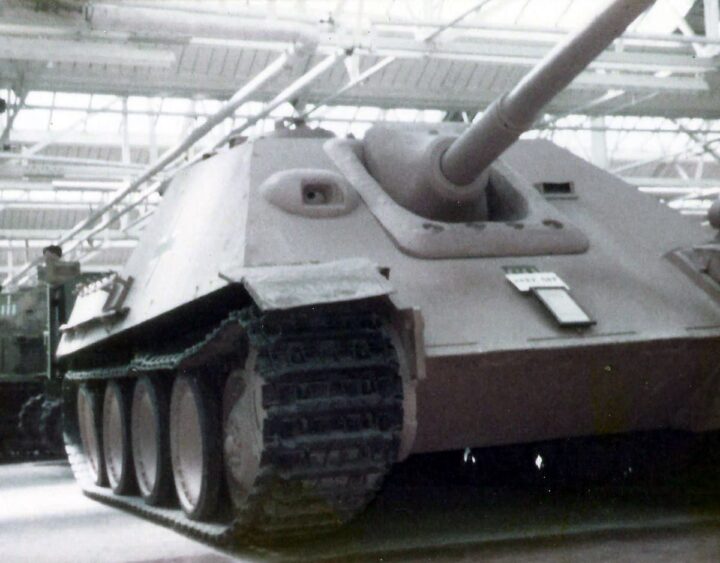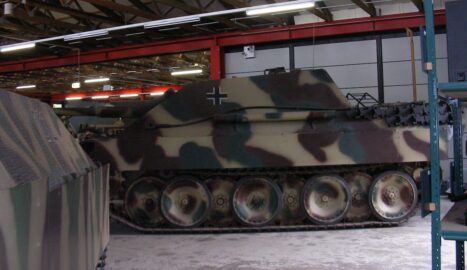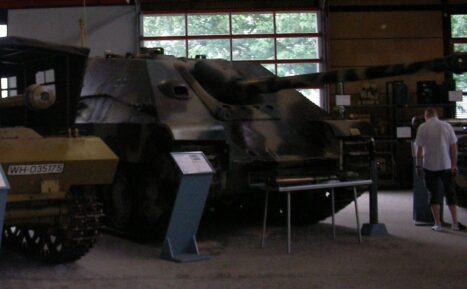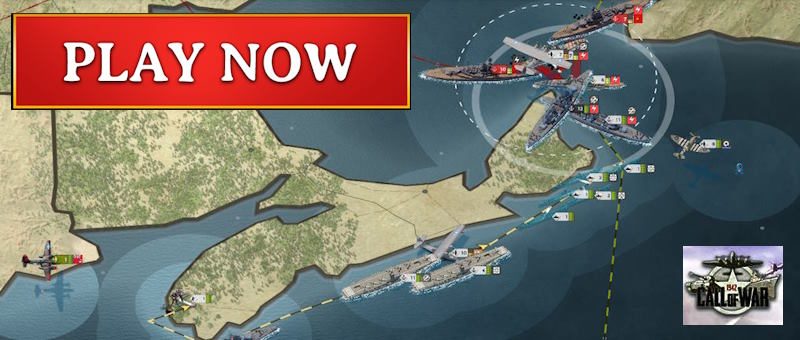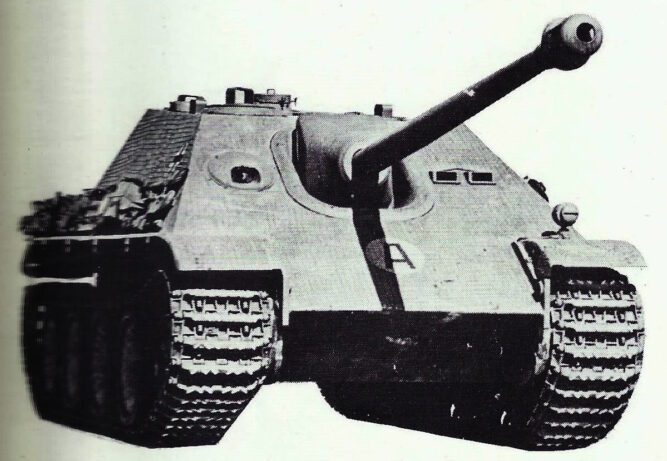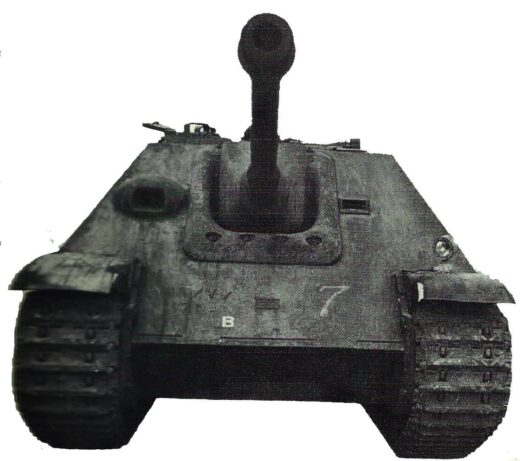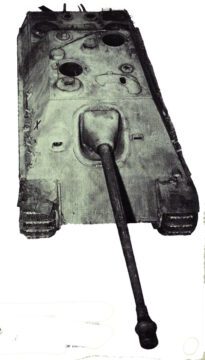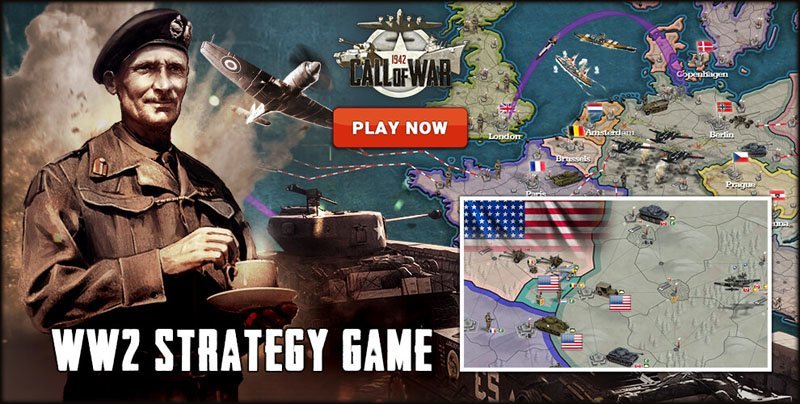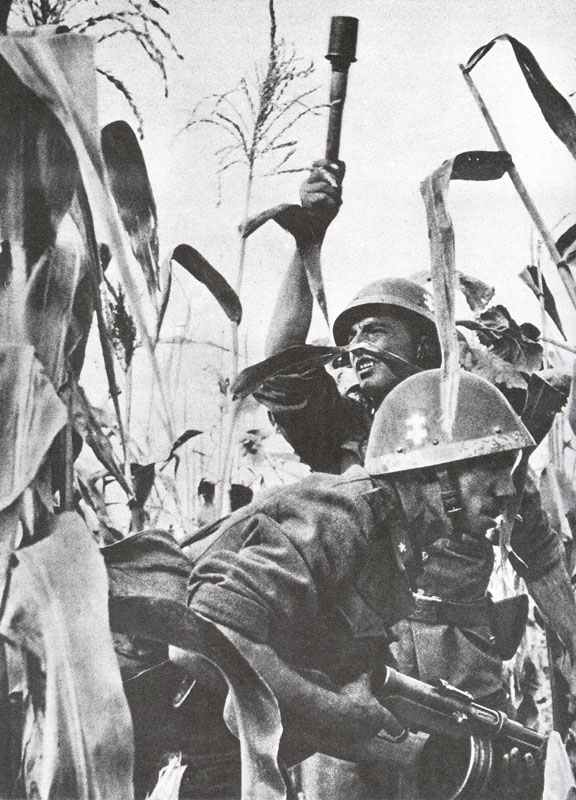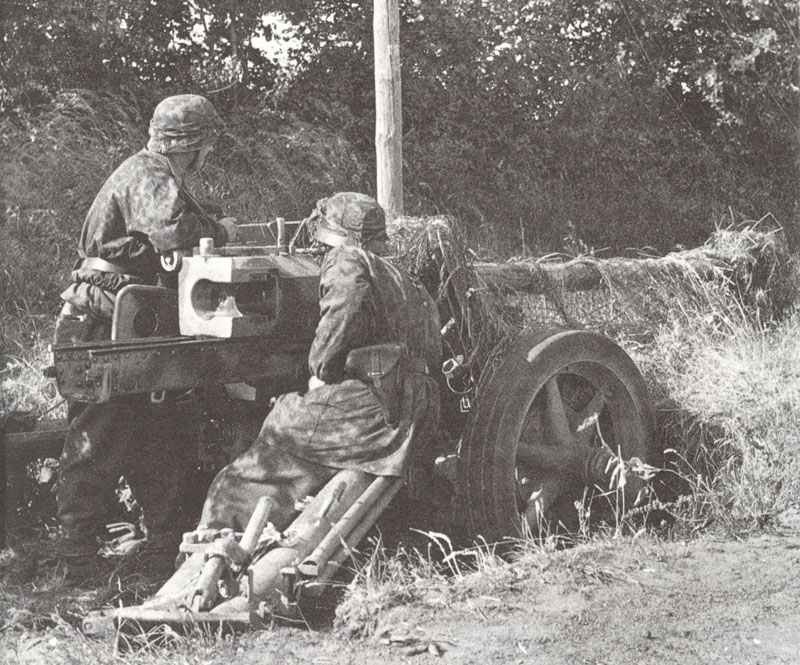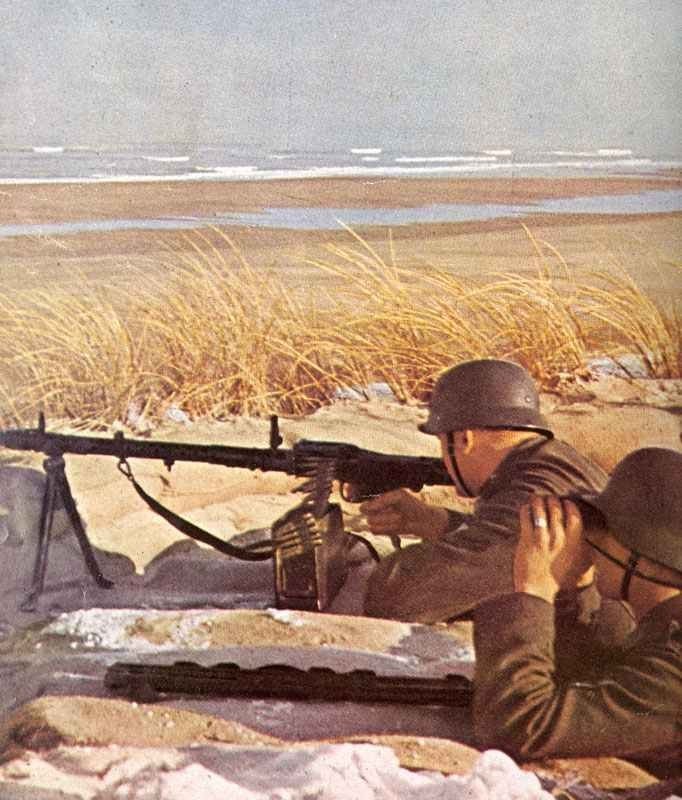Jagdpanther (SdKfz 173, tank destroyer for 8.8-cm PaK 43 on Panther chassis), probably the best German tank destroyer of the Second World War.
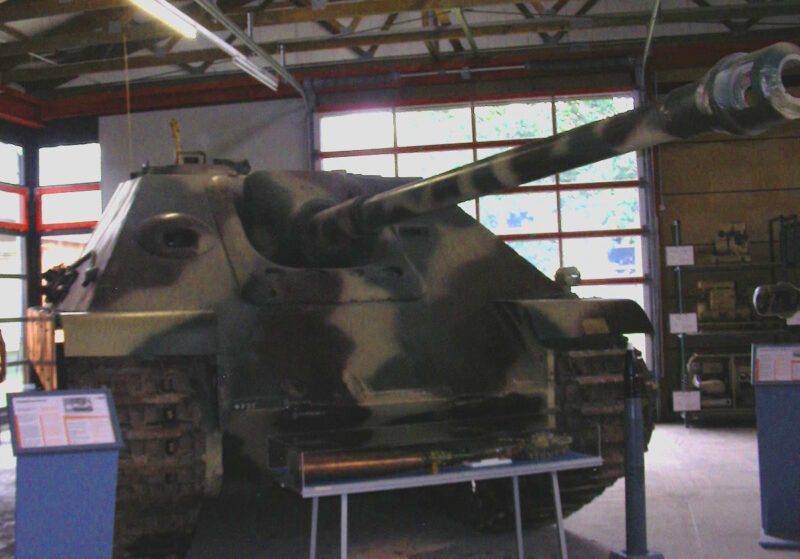
Jagdpanther (SdKfz 173)
Table of Contents
Heavy tank destroyer (tank destroyer for 8.8-cm Pak 43 on Fgst (chassis) Panther)
The history
The first attempts to make the outstanding 88-mm Flak and later 8.8-cm Pak mobile with chassis were not overly successful. The Ferdinand was too large and immobile, and the chassis of the PzKpfw IV was too small and too weakly armoured for the Nashorn.
Thus, on 3 August 1942, the Heereswaffenamt decided to use the chassis of the Panther tank for the newly developed, long 8.8 cm PaK.
The contract was initially awarded to the Krupp company, which was already working on mounting the 8.8 cm gun on a modified PzKpfw IV chassis. Krupp came to the conclusion that the Panther chassis would have to be considerably modified for this purpose, and was unable to finalise the technical drawings before January 1943. A 1:10 scale model was nevertheless completed at the end of September and a full-size model on 10 November 1942.
In the meantime, the order had already been issued on 2 October 1942 to develop a heavy assault gun with the long 8.8 cm Pak L/71 on the Panther chassis and the Army Weapons Office wanted to see the first vehicle completed in June 1943, with series production starting in July.
During a conference at Speer’s Reich Ministry for Munitions and Armaments Production on 15 October 1942, it was decided that Daimler-Benz would be commissioned to continue the development, as production was also due to start in Daimler’s assembly plant in the summer of 1943.
The Krupp company supported Daimler-Benz in the design of the vehicle and was mainly responsible for the construction of the cannon and the gun mount. Although Krupp had been replaced by Daimler-Benz as the company responsible for the design, they completed their full-size wooden model and presented it to the Waffenamt on 16 November 1942, but this model with its low silhouette bore little resemblance to the Jagdpanther that was later built.
At a conference at Daimler-Benz in Berlin on 5 January 1943, several technical specifications were laid down for the project, which was still referred to as the 8.8 cm assault gun at the time. The upper front plate was to be 100 mm thick armoured, the lower 60 mm and both were to be sloped at an angle of 55°.
The gun mantlet was to be made of molybdenum-free cast steel, bolted to the front plate so that the gun could be easily dismantled. When the gearbox and steering gear could be removed through the opening for the gun mount, the roof of the superstructure was to be welded. Instead of vision slits, two periscopes for the driver were built into the front plate and gun hatches would allow vision to the sides.
The first armoured hulls were to be delivered by the manufacturers of the armour plates in mid-1943, and the first pre-series vehicles were to be ready in December 1943.
At a conference with Hitler on 6 March 1943, the designers decided to have a closer look at the gun mantlet of the ‘Sturmgeschütz auf Panther-Fahrgestell’ to see if it was possible to use the same type of ball bearing as was used in the Porsche Sturmgeschütz (Ferdinand assault gun). They wanted to avoid the gun carriage becoming a shot trap like the Sturmgeschütz 40 (on the chassis of the PzKpfw III).
Jagdpanther in museums today: in the RAC Tank Museum (Bovington, Dorset, UK) and two further photos from the Munster Tank Museum, Germany.
A specification issued by the Waffenamt on 1 May 1943 for the vehicle now known as the ‘8.8 cm Panzerjäger 43/3 L/71 on Panther chassis’ contained the following details:
The armour thicknesses for the superstructure were 100 mm at 55° degrees for the front, 60 mm at 35° degrees for the side, 40 mm at 35° degrees for the rear and 30 mm at 80° degrees for the roof. The hull armour was 60 mm at 55° degrees for the lower front plate, 60 mm at 0° degrees for the sides, 40 mm at 35° degrees for the rear and 30 mm at 90° degrees for the deck and underbody hull. The vehicle had the same armour thicknesses as for the intended Panther II.
In addition to the 8.8 cm cannon, an MG34 machine gun and two MP 40s were carried inside the vehicle.
Sights included an SflZF5 periscope gun sight for the gunner, an SFl4Z scissor-type periscope for the commander and seven further periscopes for the crew.
A crew of five men was specified, consisting of the commander, gunner, driver and two loaders.
The radios provided, Fu 15 and Fu 16, were normally used by the artillery and not by the armoured troops. The battery and division command vehicles were equipped with an additional long-range radio, the Fu 8.
On 4 May 1943, however, it was decided to continue production of the previous Panther tank and not to introduce the Panther II. The design of the Panther II was shelved and not put into mass production.
However, as the original Daimler-Benz design for the new tank destroyer was based on the Panther II chassis, the company was now commissioned to rework the vehicle for the Panther I chassis, but to adopt simplifications from the Panther II.
These changes were quickly implemented so that the first hulls could be delivered in September 1943. The new armour thicknesses were 50 mm for the lower hull front and superstructure sides, 40 mm for the rear part of the superstructure, the hull sides and the rear. The roof and floor plates were still to be 30 mm thick. The drive train and suspension were the same as on the standard Panther I.
Due to the limited space available at Daimler-Benz Plant 40 in Berlin-Marienfelde and the problems that Daimler-Benz had to meet with the production quotas for the Panther, it was decided on 24 May 1943 that the ‘Schwere Sturmgeschütz’ should be built at MIAG in Braunschweig.
The armour thickness of the roof, the rear deck and the underbody plates was reduced to 16 mm in order to reduce the overall weight of the vehicle. As the gun was moved slightly to the right of the vehicle’s centre line to provide sufficient space for the driver, the gun’s traverse was reduced from 14° to 12° degrees to the right and left.
On 9 June 1943, the specifications stated a crew of six men, as a radio operator was added. The ammunition supply was 50 shells for the 8.8 cm gun, 30 rounds for the close defence weapon, 600 rounds for the MG42 loosely mounted in the vehicle and 760 rounds for the four submachine guns.
The SflZFIa periscope was the main gun sight. The head of this periscope protruded through an opening in the superstructure plate and moved with the main gun.
The sights consisted of two periscopes for the driver, five gun ports, one SF14Z(Sfl.) scissor periscope and two periscopes for the loader. There were three access hatches for the crew: one to the right of the centre in the roof for the commander, one to the rear left in the roof above a gunner and one centrally at the rear in the superstructure.

A full-size model of the ‘Panzerjäger mit 8,8-cm L/71 auf Panther-Fahrgestell’ was completed by Daimler-Benz in June 1943 and transferred to MIAG to help finalise the assembly drawings and construction procedures. This model was also presented to Adolf Hitler on 20 October 1943, together with wooden models of the King Tiger tank and Jagdtiger, and met with his immediate approval.
Technical details of the Jagdpanther
From the use of the Ferdinand in the Battle of Kursk, it was recognised that a fixed machine gun was needed in all armoured vehicles in order to be able to engage infantrymen and other soft targets. For this reason, an MG 34 was installed in the right front of the superstructure next to the main gun with the same ball mount as on the Panther Ausf. A.
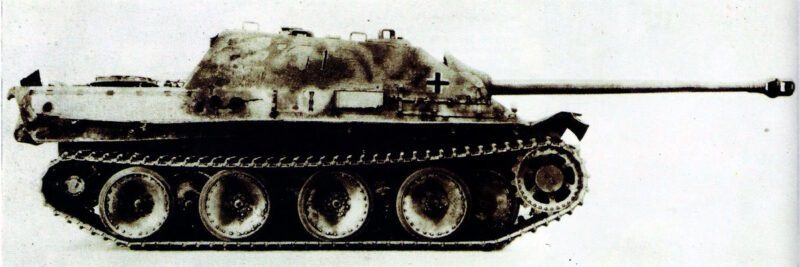
Other design changes that were made before the pre-production model was built were:
The reduction of the crew strength from six to five men, an increase in the number of shells carried for the main gun from 50 to 60 and a reduction in the number of periscopes in the superstructure from five to four, two of which were fixed and two of which could be rotated.
The drive system, the chassis, the suspension and the lower part of the hull were exactly the same as on the Panther.
The powerful Maybach HL 280 P30 12-cylinder engine produced 700 hp at 3,000 rpm via a ‘Zahnradfabrik AK 7-200’ power transmission with seven stages to the individual wheel drives and final drives, which enabled the vehicle to reach a top speed of 55 kilometres (33.5 miles) per hour.
All gearboxes in the Jagdpanther still in existence today are AK 7.200 gearboxes from the normal production series. The final drives were reinforced by a modification during series production, as there had previously been numerous failures.
The first prototype of the Jagdpanther was completed by MIAG in October and the second in November 1943 and presented to Hitler on 16 December. A letter dated 29 November 1943, later copied by the OKH on 1 February 1944, lists a number of names as suggestions for various new armoured vehicles. Among them is the designation Jagdpanther as the official name for the ‘Schwerer Panzerjäger 8,8cm auf Panther I’.
The fighting compartment of the Jagdpanther was created by extending the upper hull and the side plates of the normal Panther chassis. The 8.8cm PaK43/3 was mounted in a gun mount in this sloping front plate and in the first vehicles the mount was welded to the superstructure front plate. Later vehicles had a projecting gun mount that was bolted on. The long cannon reached almost through the entire fighting compartment of the favourably shaped superstructure and the barrel shield protected the breakthrough through the front plate.
The cannon’s traversing range was only 12° degrees to each side, and the elevation range was limited to 14° degrees. However, since the entire vehicle could be swivelled easily by means of sensitive controls, the limited side aiming angle did not carry much weight.
The Jagdpanther was designed to face the enemy with its well-armoured front. The Jagdpanzer was then extremely powerful and feared by the enemy.
Front side of early Jagdpanther models
The driver was equipped with a periscope in the front superstructure next to the gun mount, while all other crew members had a view through periscopes located in the superstructure roof.
Close defence was provided by a ‘Nahverteidigungsgerät’ (close defence weapon) mounted in the superstructure roof and a machine gun in a hull mount at the front of the superstructure.
The suspension remained unchanged compared to the Panther main battle tank, but the drive train was improved by the installation of a high-performance gearbox.
Series production of the Jagdpanther
Series production began at MIAG in January 1944 and at MNH in November 1944, with the first vehicles being delivered in February 1944.
Originally there were two designations: ‘Sturmgeschütz (assault gun) für 8,8cm StuK43 auf Fgst Panther I’ (Sd Kfz 172) and ‘Panzerjäger (tank destroyer) für 8,8cm Pak43 auf Fgst Panther I’ (SdKfz 173), but no further records of the former model are available.

To simplify production, the glacis plate of the Panther was raised up to the upper edge of the superstructure. This meant that the original hull could be used with just a few modifications. As the side walls of the original Panther were too steeply inclined and would therefore have left too little space in the fighting compartment, the angle of inclination was changed for the Jagdpanther. This change was later also adopted for the Panther Ausf G, which also significantly improved the armoured fighting vehicle’s protection.
Due to the higher weight of the Jagdpanther, the AK7-400 transmission was used, which was subsequently also used on the Panther main battle tank for the same reason.
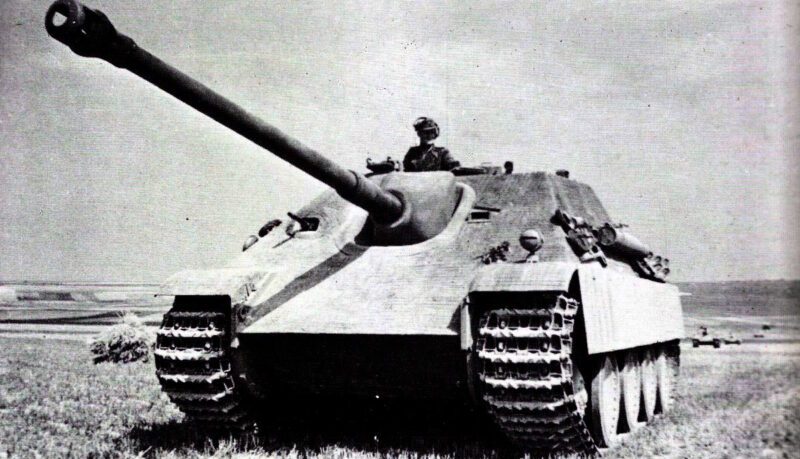
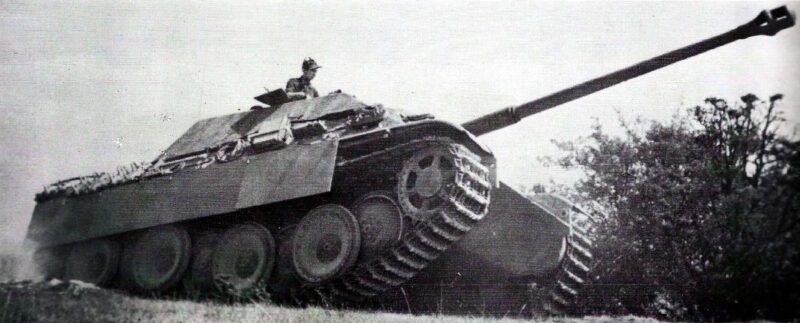
Some 413 Jagdpanthers were built by MIAG, MNH and MBA with chassis serial numbers starting at 300,001 from January 1944 until the Allied occupation of factories in April 1945. MIAG and MNH together only built around 382 of these, although the original plan was to produce 150 vehicles per month.
Jagdpanther in service
The first Jagdpanthers were delivered to the 559th and 654th Panzerjäger Abteilungen (tank destroyer detachments) in June 1944. Only the latter unit was fully equipped with the new tank destroyer. The company strength was ten to fourteen Jagdpanthers.
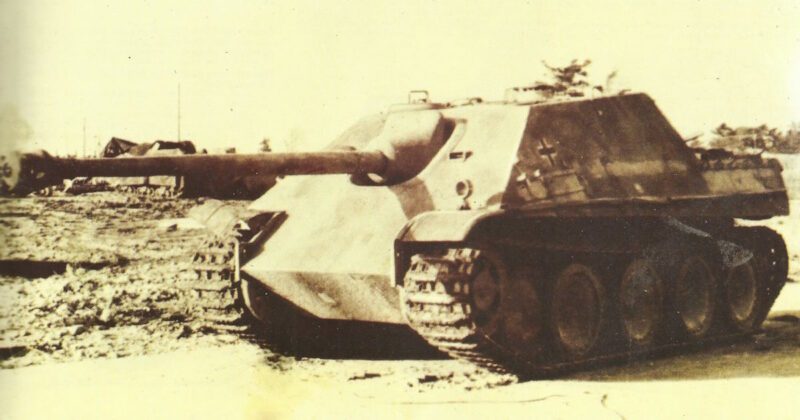
The Jagdpanther was first issued to the Heeres-Panzerjäger-Abteilung 654, the only unit to receive three companies (ten to fourteen tanks each) and also the first unit to use it in combat in the west. As a further unit, the 559th Panzerjäger-Abteilungen received a company of Jagdpanthers.
A further company from each of the four heavy army tank destroyer detachments (including the 559th) was equipped with the Jagdpanther and deployed on the Western Front.
These special tank destroyer detachments were usually subordinate to higher corps or army staffs as a reserve. On paper, a Jagdpanzer battalion was supposed to have 30 Jagdpanthers, but most had to make do with fewer due to supply difficulties.
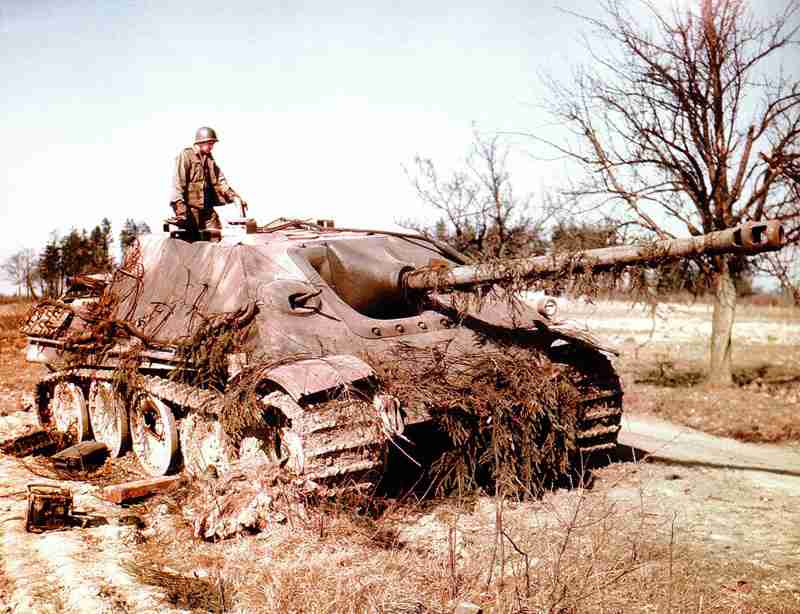
The largest collection of Jagdpanther available during the war was made available in December 1944 for participation in the Battle of the Bulge.
Finally, in January 1945, a company from each of two heavy army tank destroyer detachments was equipped with Jagdpanther and sent to the Eastern Front. From the same date, the Jagdpanther equipped a company in several Panther divisions.
From January 1945 until the end of the war, they were also issued to the tank divisions of a total of seven different tank divisions, to the Führer Grenadier Division and to a tank brigade.
Even with its superior armament, armor protection and mobility, however, the Jagdpanther was introduced to the troops too late and in too small numbers to pose more than a local tactical problem for Allied tank crews.
It was therefore fortunate for the Allied forces that so few of what was probably the best tank destroyer of the Second World War were used. Due to its speed, mobility, armament and armor, the Jagdpanther was very strong in combat and its opponents gave it a wide berth whenever possible. The crews liked their vehicle, which boosted morale and the will to fight.
The only drawback was the complicated undercarriage, which could immobilize the vehicle with a well-aimed or lucky hit, making it easy for the enemy to approach from the side.
Animated 3d model of Jagdpanther
Variants of the Jagdpanther
In an attempt to mount their 12.8-cm L/55 cannon on the Panther chassis, a series of design sketches numbered Hin-A 146 and Hin-B 147 were submitted by the Krupp company on November 24, 1944. These showed a fighting compartment at the rear of the vehicle, while the engine was relocated to the center of the hull.
Obviously, such a radical modification was no longer taken seriously at this point in the war and the idea was discarded.
Only one variant of the Jagdpanther was actively pursued: the rigid mounting of the 8.8 cm L/71 cannon. The elimination of the recoil gearbox promised savings in material, weight and production time. The first tests were carried out with the 7.5-cm L/48 gun on the Jagdpanzer 38(t) Hetzer, but the designers were no longer able to transfer the experience gained there to the 8.8-cm L/71 of the Jagdpanther.
The Krupp company was also involved in this development and suggested installing the 8.8 cm L/71 further back in the Jagdpanther. Due to the critical war situation, this project came to nothing.
Specifications Jagdpanther
Specifications:
| Specification | Jagdpanther |
|---|---|
| Type | heavy tank destroyer |
| Engine | Carburettor engine Maybach HL230P30 (700 PS at 3000 rpm, 600 PS at 2500 rpm) |
| Gearbox | ZF-Synchron AK7-400 with 7 forward and 1 reverse |
| Crew | 5 |
| Length (over all) | 32.35 ft (9.86 m) - without gun 22.54 ft (6.87 m) |
| Width | 11.22 ft (3.42 m) - without skirts: 10.72 ft (3.27 m) |
| Height | 8.91 ft (2.715 m) |
| Weight | 101,413 lb (46,000 kg) |
| Maximum road speed | 28 mph (46 km/hr) |
| Cross-country speed | 14.5 mph (24 km/hr) |
| Fuel consumption per 100 km | 460 liters on road; 690 liters cross-country |
| Fuel | 600 liters |
| Road radius | 90 - 95 miles (150-160 km) |
| Cross-country radius | 60 miles (100 km) |
| Vertical obstacle | 3 ft (0.91 m) |
| Trench crossing | 8 ft (2.45 m) |
| Fording depth | 5 ft (1.55 m) |
| Turning circle | 32.8 ft (10.00 m) |
| Climbing power | 35° |
Armor:
| Specification | mm | angle |
|---|---|---|
| Superstructure front | 80 | 55° |
| Superstructure side | 50 | 30° |
| Superstructure rear | 40 | 35° |
| Superstructure top | 25 + 16 | 83° + 90° |
| Hull front | 60 | 55° |
| Hull side | 40 | 0° |
| Hull rear | 40 | 25° |
| Hull bottom | 25-16 | 90° |
| Gun mantlet | 100 | Saukopfblende (round) |
Armament and Equipment:
| Jagdpanther | Specification |
|---|---|
| Main armament | 8.8cm PaK43/3 |
| Rounds | 57 |
| Traverse | left 13° - right 13° (by hand) |
| Elevation | -8° to +14° |
| Muzzle velocity Pzgr39-1 | 3,281 ft/sec (1000 m/sec) |
| Muzzle velocity Pzgr40/43 | 3,707 ft/sec (1130 m/sec) |
| Shell weight Pzgr39-1 | 22.49 lb (10.2 kg) |
| Shell weight Pzgr40/43 | 16.09 lb (7.3 kg) |
| Maximum fire range | 5.905 yards; effective 2.734 yards (5.400 m; effective 2,500 m) |
| Secondary armament | 1 x 7,92mm MG34 (600 rounds) |
| Radio | FuG5 and FuG2 (2-4 km range) |
| Telescopic sight | SflZF5 (maximum 3,2881 yards/3,000 m APC; 5,905 yards/5,400 m HE; 16,732 yards/15.300 m indirect fire) |
Penetration mm at 30° armor plates of the gun:
| Range | Pzgr39-1 | Pzgr40/43 |
|---|---|---|
| 100 meters | 203 mm | 237 mm |
| 500 meters | 185 mm | 217 mm |
| 1,000 meters | 165 mm | 193 mm |
| 1,500 meters | 148 mm | 171 mm |
| 2,000 meters | 132 mm | 153 mm |
| 2,500 meters | 127 mm | ? |
Production:
| Figures | Jagdpanther |
|---|---|
| Production | January 1944 - April 1945 |
| Price per tank | ? (PzKpfw V Panther D: 117.100 RM without weapons + 26.000 RM 8,8-cm Pak 43 L/71) [1 RM = $0.45) |
| Total production figure | 392 (at MIAG and MNH from Jan 1944 to March 1945); total c. 413 |
Service statistics:
| Year | Available | Production | Losses |
|---|---|---|---|
| before 1939 | - | - | - |
| 1939 | - | - | - |
| 1940 | - | - | - |
| 1941 | - | - | - |
| 1942 | - | - | - |
| 1943 | - | 1 | - |
| 1944 | - | 226 | 33 |
| 1945 | 149 | 114 (Jan+Feb) | 17 (Jan) |
| Total | - | 341 (until Feb 45) | 50 (until Jan 45) |
Action with Jagdpanther in video games
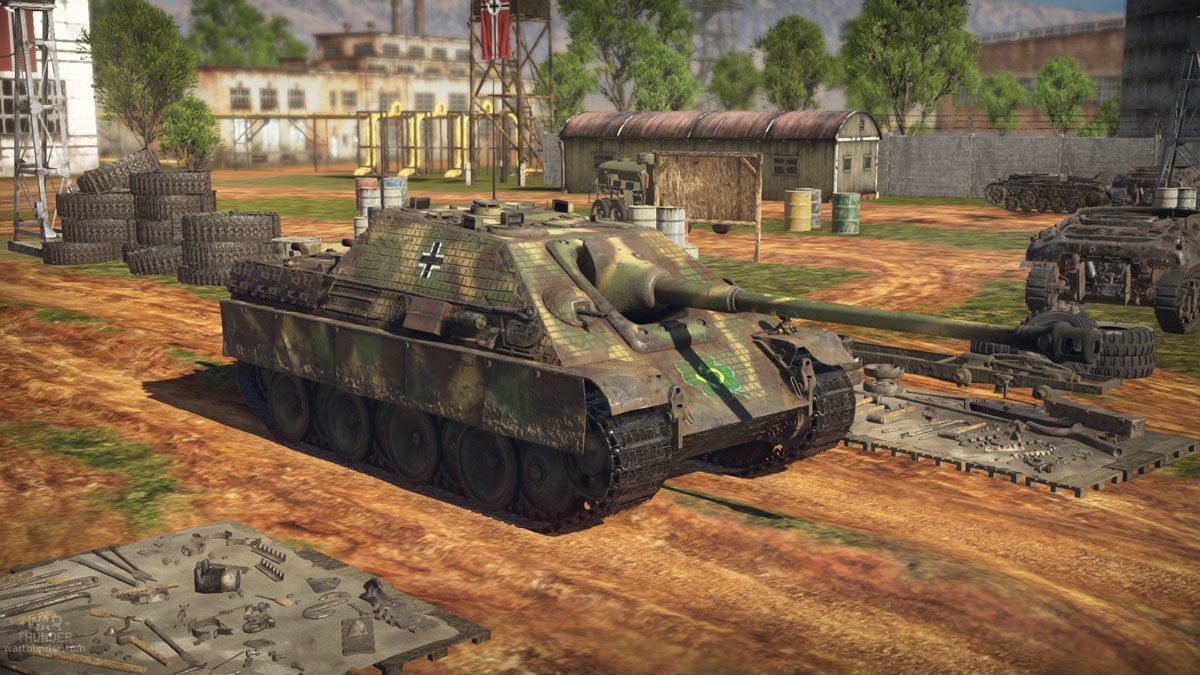
Video of a mission with Jagdpanther and Do 335 Arrow B-2 in a ‘Realistic Ground Battle’ of the free2play game War Thunder:
Who does not know the F2P tank and plane war game War Thunder can download it from here for free:
References and literature
Kraftfahrzeuge und Panzer der Reichswehr, Wehrmacht und Bundeswehr (Werner Oswald)
Encyclopedia of German Tanks of World War Two (P.Chamberlain, H.L.Doyle)
Panther Variants 1942-1945 (Hilary Doyle&Tom Jentz)
Panzer und andere Kampffahrzeuge von 1916 bis heute (Christopher F. Foss, John F. Milsom, Colonel John Stafford Weeks, Captain Georffrey Tillotson, Richard M. Ogorkiewicz)


